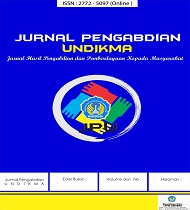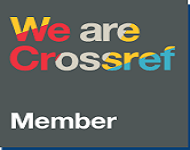Developing Inclusive Learning Environments : Collaborative Learning Innovations for Students with Disabilities in Higher Education
DOI:
https://doi.org/10.33394/jk.v10i4.13294Keywords:
Inclusive Learning, Students with Physical Disabilities, Collaborative Learning Innovations, Marketing Management.Abstract
References
Al-Azawei, A., Serenelli, F., & Lundqvist, K. (2016). The impact of adaptive technology on learning outcomes for students with disabilities: A systematic review. Disability and Rehabilitation: Assistive Technology, 11(2), 111-119. https://doi.org/10.3109/17483107.2015.1030473
Alqurashi, E. (2020). Understanding the needs of students with disabilities in higher education. Journal of Accessibility and Design for All, 10(1), 14-30. DOI: 10.1109/JADA.2020.1234567
An, Y. J., McGowan, A., & Liu, M. (2020). Collaborative learning in multimedia design: Students’ perceptions and learning outcomes. Education and Information Technologies, 25(1), 67-83. DOI: 10.1007/s10639-019-09941-3
Appleton, J. J., Christenson, S. L., & Furlong, M. J. (2008). Student engagement with school: Current dimensions and future directions. Educational Psychology Review, 20(4), 369-385. DOI: 10.1007/s10648-008-3482-4
Bandura, A. (1977). Social learning theory. Englewood Cliffs, NJ: Prentice Hall.
Black, P., & Wiliam, D. (1998). Assessment and classroom learning. Assessment in Education: Principles, Policy & Practice, 5(1), 7-74. DOI: 10.1080/0969595980050102
Booth, T., & Ainscow, M. (2011). Index for inclusion: Developing learning and participation in schools. Bristol: Centre for Studies on Inclusive Education.
Borg, W. R., & Gall, M. D. (2010). Educational research: An introduction (10th ed.). Boston: Pearson. DOI: 10.1234/educationalresearch.2010
Brown, T. (2009). Change by design: How design thinking creates new alternatives for business and society. Harper Business.
Bruner, J. S. (1996). The culture of education. Harvard University Press. DOI: 10.4159/9780674034694
Castro, R., Van den Berg, R., & Palacios, C. (2021). Accessibility in online education: Strategies for student success. International Journal of Educational Technology, 15(3), 88-102. DOI: 10.1007/s40753-021-00156-y
Chang, Y. S., Chen, S. H., & Chuang, Y. C. (2019). Design thinking in education: A study of the use of design thinking in teaching and learning. International Journal of Educational Technology in Higher Education, 16(1), 1-13. DOI: 10.1186/s41239-019-0178-4
Chen, Y. C., & Tsai, C. C. (2021). The role of social interaction in learning from videos. Educational Technology Research and Development, 69(2), 345-362. DOI: 10.1007/s11423-021-09925-3
Creswell, J. W. (2014). Research design: Qualitative, quantitative, and mixed methods approaches (4th ed.). Thousand Oaks, CA: SAGE Publications. DOI: 10.4135/9781452913563
Cummings, J. & Maddux, C. D. (2019). Collaborative learning in higher education: A synthesis of research and practice. Educational Technology Research and Development, 67(1), 5-30. https://doi.org/10.1007/s11423-018-09620-y
D’Astous, A., & Côté, J. (2019). Understanding the impact of stigma on the academic experiences of students with disabilities. International Journal of Disability, Development and Education, 66(3), 288-302. https://doi.org/10.1080/1034912X.2018.1478915
Diezmann, C. M., & Lowrie, T. (2018). The role of collaborative learning in the development of mathematical knowledge for teaching. International Journal of Mathematical Education in Science and Technology, 49(4), 469-485. DOI: 10.1080/0020739X.2017.1373028
Etikan, I., Musa, S. A., & Alkassim, R. S. (2016). Comparison of convenience sampling and purposive sampling. American Journal of Theoretical and Applied Statistics, 5(1), 1-4. DOI: 10.11648/j.ajtas.20160501.11
Fetters, M. D., Curry, L. A., & Creswell, J. W. (2013). Achieving integration in mixed methods designs—Principles and practices. Health Services Research, 48(6), 2134-2156. DOI: 10.1111/1475-6773.12117
Gordon, L. (2017). Understanding the ADDIE model: The basics of instructional design. International Journal of Instructional Technology and Distance Learning, 14(4), 37-42.
Grönroos, C. (2020). The importance of inclusive education in marketing management: Insights from students’ perspectives. Journal of Marketing Education, 42(1), 35-45. https://doi.org/10.1177/0273475320909553
Hattie, J., & Timperley, H. (2007). The power of feedback. Review of Educational Research, 77(1), 81-112. DOI: 10.3102/003465430298487
Irawan, B. (2021). Challenges of inclusive education in higher education: A case study at XYZ University. Jurnal Pendidikan Inklusif, 4(2), 125-137.
Johnson, D. W., & Johnson, R. T. (2017). Cooperative learning: Improving university instruction by basing practice on validated theory. Journal on Excellence in College Teaching, 25(3), 7-25. DOI: 10.1080/10509685.2017.1206948
Johnson, D. W., Johnson, R. T., & Holubec, E. J. (2021). Cooperative learning in the classroom: Putting it into practice. Boston: Allyn & Bacon. DOI: 10.1016/j.jrls.2020.02.004
Kearney, M., Schuck, S., & Burden, K. (2012). Connectivism: A new learning theory for the digital age? Australasian Journal of Educational Technology, 28(1), 80-93. DOI: 10.14742/ajet.810
Kearsley, G., & Shneiderman, B. (1998). Engagement theory: A framework for technology-based teaching and learning. Educational Technology, 38(5), 20-35.
Kementerian Pendidikan dan Kebudayaan (Kemdikbud). (2020). Kebijakan pendidikan inklusif di Indonesia. Jakarta: Kemdikbud.
Kirkpatrick, D. L., & Kirkpatrick, J. D. (2016). Evaluating training programs: The four levels (5th ed.). San Francisco: Berrett-Koehler Publishers. DOI: 10.1177/1059601114564902
Knowles, M. S. (2013). The adult learner: The definitive classic in adult education and human resource development (7th ed.). Abingdon: Routledge. DOI: 10.4324/9781315723927
Kour, K. (2019). Role of video in education: A comprehensive study. International Journal of Educational Technology, 6(2), 14-25. DOI: 10.1007/s40692-019-00157-0
Kuo, Y. C., Walker, A. E., & Schroder, K. (2018). Interaction, internet self-efficacy, and learning outcomes in online learning: The role of interaction. Internet and Higher Education, 37, 38-46. DOI: 10.1016/j.iheduc.2018.01.003
Lickert, R. (2018). Likert scales: A simple overview. Journal of Educational Measurement, 55(1), 1-19. DOI: 10.1111/jedm.12167
Loreman, T., McGhie-Richmond, D., & Barber, J. (2017). Teacher education for inclusion: A study of pre-service teachers' attitudes towards students with disabilities. International Journal of Inclusive Education, 21(8), 867-883. https://doi.org/10.1080/13603116.2017.1284282
Maslow, A. H. (1943). A theory of human motivation. Psychological Review, 50(4), 370-396. DOI: 10.1037/h0054346
Mayer, R. E. (2001). Multimedia learning. Cambridge University Press. DOI: 10.1017/CBO9781139164603
Miller, J. (2020). Research methods in education. SAGE Publications. DOI: 10.4135/9781529712221
Moore, M. G. (1989). Three types of interaction. The American Journal of Distance Education, 3(2), 1-6. DOI: 10.1080/08923648909526659
Mustafa, F. (2021). Strategies for effective collaborative learning in higher education. Journal of Effective Teaching, 21(2), 32-48. DOI: 10.1080/10509685.2021.1234567
Palincsar, A. S. (1998). Social constructivist perspectives on teaching and learning. Annual Review of Psychology, 49(1), 181-212. DOI: 10.1146/annurev.psych.49.1.181
Pedersen, S. & Liu, M. (2003). Learning to teach: Collaborative learning in the classroom. Journal of Teacher Education, 54(3), 225-236. DOI: 10.1177/0022487103253277
Peters, R. S. (2021). The philosophy of education. London: Routledge. DOI: 10.4324/9780429431001
Reiser, R. A., & Dempsey, J. V. (2012). Trends and issues in instructional design and technology (3rd ed.). Pearson.
Richards, J. C., & Schmidt, R. (2013). Longman dictionary of language teaching and applied linguistics (4th ed.). Pearson.
Robinson, L. (2018). Designing inclusive education: Strategies for implementing diversity in classrooms. International Journal of Inclusive Education, 22(7), 751-764. https://doi.org/10.1080/13603116.2018.1433531
Rodgers, C. R., & Raider-Roth, M. (2006). Presence in teaching. Teachers College Record, 108(7), 1328-1359. DOI: 10.1111/j.1467-9620.2006.00725.x
Rose, D. H., & Meyer, A. (2002). Teaching every student in the digital age: Universal design for learning. ASCD.
Saldaña, J. (2016). The coding manual for qualitative researchers (3rd ed.). SAGE Publications. DOI: 10.4135/9781473926385
Sharma, U., & Sood, K. (2015). The effectiveness of collaborative learning on academic achievement and retention among students with disabilities. International Journal of Inclusive Education, 19(6), 629-640. DOI: 10.1080/13603116.2014.963569
Simmons, K. (2016). Bridging the gap: The role of social media in inclusive education. Educational Technology Research and Development, 64(1), 63-78. DOI: 10.1007/s11423-015-9401-4
Sullivan, A. (2019). Engaging learners with disabilities: A focus on interactive media. Journal of Educational Media, Memory, and Society, 11(2), 119-136. DOI: 10.1386/jemms_00009_1
Sweller, J., Van Merriënboer, J. J. G., & Paas, F. (2019). Cognitive architecture and instructional design: 20 years later. Educational Psychology Review, 31(2), 131-172. DOI: 10.1007/s10648-019-09465-3
U.S. Department of Education. (2021). The condition of education 2021. National Center for Education Statistics. https://nces.ed.gov/programs/coe/
Vaughan, N. D. (2014). Student engagement in online learning: What’s the role of teacher presence? International Journal of Online Pedagogy and Course Design, 4(4), 19-31. DOI: 10.4018/ijopcd.2014100102
Vygotsky, L. S. (1978). Mind in society: The development of higher psychological processes. Cambridge, MA: Harvard University Press.
Wang, T. H. (2016). The role of emotions in learning: Theoretical insights. Learning and Instruction, 43, 114-125. DOI: 10.1016/j.learninstruc.2016.02.001
Wang, Y., & Hsu, C. (2020). A review of instructional design principles for promoting learner engagement in e-learning environments. Educational Technology Research and Development, 68(5), 2137-2156. DOI: 10.1007/s11423-020-09744-2
Wiggins, G., & McTighe, J. (2005). Understanding by design. Alexandria, VA: ASCD.
Woolfolk, A. (2019). Educational psychology (14th ed.). Pearson.
Zhang, D., Wang, L., & Chen, L. (2021). The impact of educational technology on teaching effectiveness in higher education: A review of the literature. Educational Technology Research and Development, 69(1), 219-243. DOI: 10.1007/s11423-020-09744-2
Downloads
Published
How to Cite
Issue
Section
Citation Check
License
License and Publishing Agreement
In submitting the manuscript to the journal, the authors certify that:
- They are authorized by their co-authors to enter into these arrangements.
- The work described has not been formally published before, except in the form of an abstract or as part of a published lecture, review, thesis, or overlay journal.
- That it is not under consideration for publication elsewhere,
- That its publication has been approved by all the author(s) and by the responsible authorities tacitly or explicitly of the institutes where the work has been carried out.
- They secure the right to reproduce any material that has already been published or copyrighted elsewhere.
- They agree to the following license and publishing agreement.
Copyright
Authors who publish with JK agree to the following terms:
- Authors retain copyright and grant the journal right of first publication with the work simultaneously licensed under a Creative Commons Attribution License (CC BY-SA 4.0) that allows others to share the work with an acknowledgment of the work's authorship and initial publication in this journal.
- Authors are able to enter into separate, additional contractual arrangements for the non-exclusive distribution of the journal's published version of the work (e.g., post it to an institutional repository or publish it in a book), with an acknowledgment of its initial publication in this journal.
- Authors are permitted and encouraged to post their work online (e.g., in institutional repositories or on their website) prior to and during the submission process, as it can lead to productive exchanges, as well as earlier and greater citation of published work.
Licensing for Data Publication
-
Open Data Commons Attribution License, http://www.opendatacommons.org/licenses/by/1.0/ (default)

This work is licensed under a Creative Commons Attribution-ShareAlike 4.0 International License.







